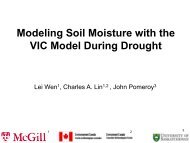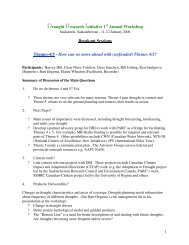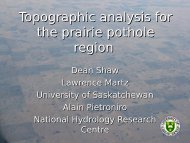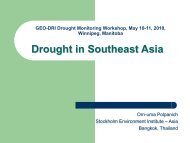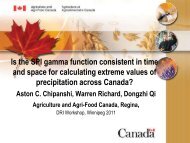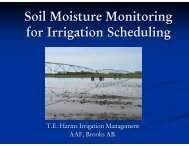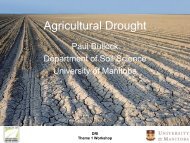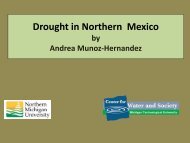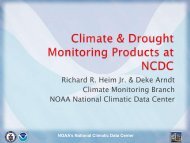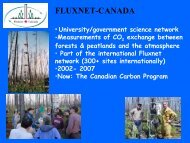Atmospheric Moisture and Thunderstorm Drought Geoff Strong
Atmospheric Moisture and Thunderstorm Drought Geoff Strong
Atmospheric Moisture and Thunderstorm Drought Geoff Strong
Create successful ePaper yourself
Turn your PDF publications into a flip-book with our unique Google optimized e-Paper software.
<strong>Atmospheric</strong> <strong>Moisture</strong><br />
<strong>and</strong><br />
<strong>Thunderstorm</strong> <strong>Drought</strong><br />
‘drought summer’<br />
<strong>Geoff</strong> <strong>Strong</strong><br />
University of Alberta<br />
Edmonton<br />
‘normal summer’<br />
1<br />
Severe thunderstorm northwest of Swift Current, SK, July 1994
Severe thunderstorms do still occur during droughts!<br />
Pine Lake Tornado storm – 14 July 2000<br />
* most severe storm of 2000 in all of North America.<br />
2
Severe thunderstorms<br />
also occur near the<br />
initiation <strong>and</strong> the<br />
cessation of summer<br />
drought periods<br />
hence the title of this study,<br />
<strong>Thunderstorm</strong> <strong>Drought</strong><br />
3
The Prairies are extremely dependent on summer precipitation!<br />
-where ‘summer’<br />
-= June/July/August<br />
4
Climate Change Studies – much emphasis on temperature trends<br />
– atmospheric moisture is relatively ignored<br />
Short-term cycles & climate trends in temperature <strong>and</strong> moisture<br />
<strong>Thunderstorm</strong> Energy source from diurnal increases in sensible <strong>and</strong> latent heat<br />
<strong>Drought</strong> results from normal (or above) sensible heating (surface temperatures)<br />
but a definite lack of latent heating (moisture)<br />
5
Climate Trends in <strong>Atmospheric</strong> <strong>Moisture</strong>*<br />
Saskatoon<br />
<br />
- winter<br />
<br />
Saskatoon - summer<br />
<br />
Edmonton - summer<br />
Winnipeg - summer<br />
* Mixing Ratio = mass (g) of water vapour per kg of dry air<br />
- from <strong>Strong</strong> (2005)<br />
6
More important to look at the ‘total’ <strong>Atmospheric</strong> <strong>Moisture</strong><br />
From radiosondes we can derive<br />
the precipitable water*<br />
Precipitable water = depth of water if total atmospheric<br />
column of moisture were<br />
condensed to liquid<br />
= maximum possible precipitation<br />
for that location <strong>and</strong> time<br />
7
GPS vs. Radiosonde<br />
Precipitable Water (mm)<br />
(A-GAME - July/2003)<br />
GPS vs. EA3 Radiosonde<br />
Olds-Didsbury Airport<br />
27-24<br />
27-00<br />
26-00<br />
25-00<br />
24-00<br />
23-00<br />
22-00<br />
21-00<br />
20-00<br />
19-00<br />
18-00<br />
17-00<br />
Time<br />
Three Hills GPS Olds GPS Sundre EA3<br />
8<br />
27-24<br />
27-24<br />
27-00<br />
26-00<br />
27-00<br />
26-00<br />
25-00<br />
25-00<br />
GPS vs. EF4 Radiosonde<br />
24-00<br />
23-00<br />
22-00<br />
21-00<br />
20-00<br />
19-00<br />
18-00<br />
17-00<br />
Time<br />
Airdrie GPS Calgary GPS EF4<br />
GPS vs. WAV Radiosonde<br />
Sundre Airport<br />
24-00<br />
23-00<br />
22-00<br />
21-00<br />
20-00<br />
19-00<br />
18-00<br />
17-00<br />
16-00<br />
16-00<br />
15-00<br />
15-00<br />
14-00<br />
14-00<br />
25<br />
20<br />
15<br />
10<br />
5<br />
0<br />
25<br />
20<br />
15<br />
10<br />
5<br />
0<br />
- from Smith, Skone, & <strong>Strong</strong> (2003)<br />
16-00<br />
15-00<br />
25<br />
20<br />
15<br />
10<br />
5<br />
0<br />
14-00<br />
Time<br />
Sundre GPS WAV<br />
q (mm)<br />
q (mm)<br />
q (mm)<br />
Airdrie Airport
INITIAL QUESTIONS TO ADDRESS:<br />
1) Given climate warming at the surface (since early 70s),<br />
- what evidence for warming in the troposphere (surface-10 km)<br />
- tropospheric moisture changes<br />
- effects on surface precipitation patterns<br />
4) What tropospheric changes are observable for the drought period, 1999-2004<br />
5) Quantify causative trends in convective weather activity, particularly with respect to<br />
initiation <strong>and</strong> cessation of drought<br />
6) Effects on the prairie water budget (atmospheric moisture/surface water)<br />
DATA REQUIREMENTS:<br />
1) Surface temperature, humidity, <strong>and</strong> precipitation for 1971-2005 (or later)<br />
2) Radiosonde data (P/T/RH) for Edmonton, The Pas (& adjacent sites) for at least 1980-2005.<br />
3) Available GPS PW data from UofC Geomatics Engineering Department (2003-)<br />
4) Archived CMC Run-0 model-assimilated data (prairies) for 1998-2005.<br />
5) Convective weather information (radar, satellite, lightning, ground observations)<br />
9
Applications to DRI Goals:<br />
1) Quantify changes in tropospheric temperatures & moisture over last 35 years,<br />
<strong>and</strong> during the focus drought period, 1999-2004,<br />
2) How do these changes affect precipitation patterns<br />
3) Can we detect causative trends in convective weather activity from this, particularly<br />
with respect to the initiation <strong>and</strong> cessation of drought<br />
4) Continued collaboration with Skone/Smith on GPS ‘PW’:<br />
- to quantify diurnal changes in evapotranspiration<br />
- as a means to detect early onset <strong>and</strong> cessation of seasonal drought.<br />
5) Collaboration with Hanesiak/Szeto/Stewart/Snelgrove on closing the prairie water budget.<br />
<br />
10



